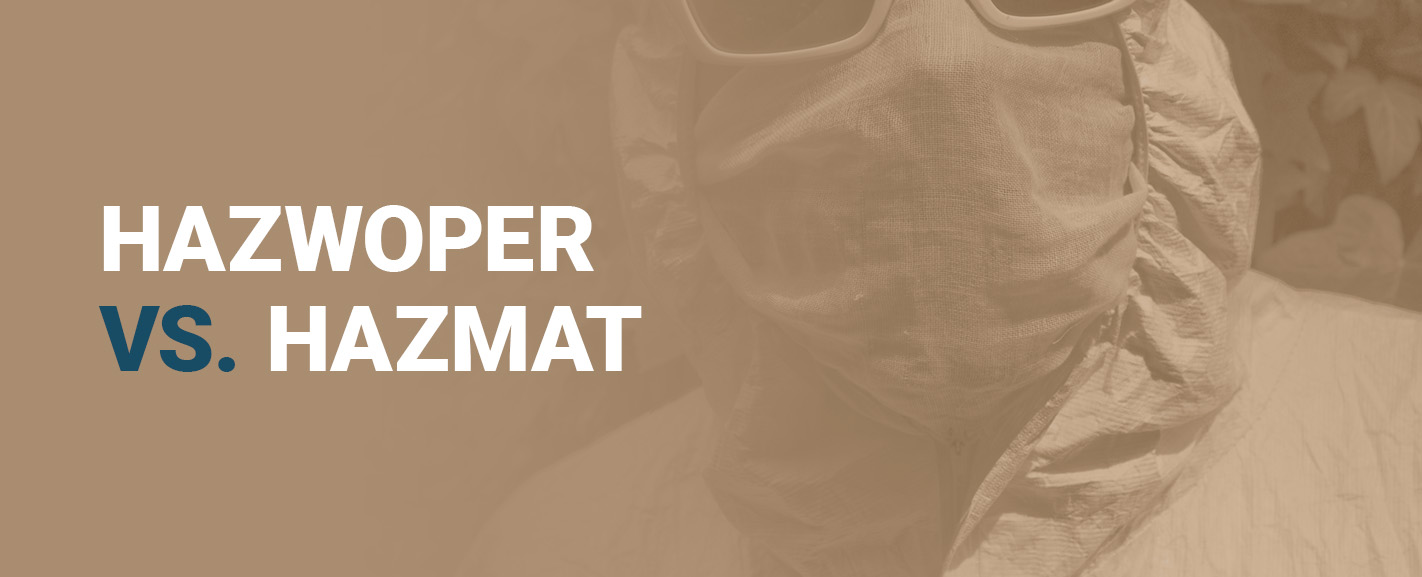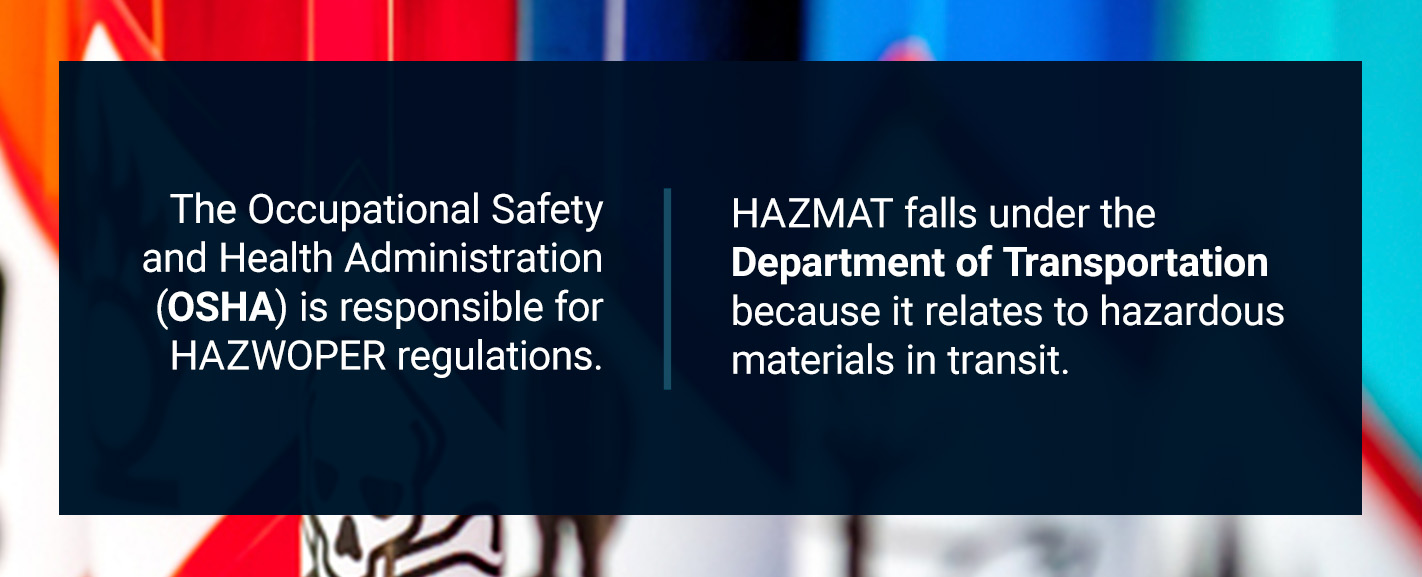
Jump To:
Many industries deal with hazardous materials, ranging from manufacturing, petrochemical, healthcare and laboratory science to transportation. With the prevalence of these substances, the government created regulations for handling these materials in various circumstances. Keeping hazardous materials under control is essential for protecting people and the environment.
HAZWOPER and HAZMAT training are two well-known protocols within hazardous material management, and they’re often confused for one another. However, these two provisions have distinct differences, and they need to be recognized as separate entities for the sake of training. Understanding the differences can ensure you receive the proper certifications for your involvement with hazardous materials.
What Is HAZWOPER?
HAZWOPER stands for Hazardous Waste Operations and Emergency Response. This training is designated to help workers respond to hazardous materials on the job safely and effectively, and it includes two different aspects of hazardous waste handling.
HAZWOPER covers:
- The federal, state, local and other government cleanup operations required at uncontrolled hazardous waste sites.
- Corrective actions for cleanup operations at locations under the Resource Conservation and Recovery Act (RCRA).
- Hazardous waste operations at treatment, storage and disposal (TSD) sites covered by the RCRA.
- Non-TSD facilities that generate hazardous waste.
- Emergency response operations where a hazardous substance is released or threatened to be released, regardless of location.
Cleanup and corrective action for these operations are environmental remediation processes at locations where workers may be exposed to hazardous substances, like abandoned industrial sites.
TSD locations are permitted to receive, store, treat and dispose of hazardous waste, and they must have protocols in place for working through these processes. In the case of non-TSD facilities, HAZWOPER defines protocols for handling uncontrolled releases of hazardous substances. These sites may include manufacturing buildings and other operations that produce hazardous waste as a by-product.
All of the above situations comply with 29 CFR 1910.120 in the HAZWOPER regulations.
The emergency response side of HAZWOPER is slightly different from the other scenarios covered under the regulation. This aspect recognizes that many operations have a risk of releasing hazardous substances, including laboratories, chemical facilities, railroads, universities and more.
Under the emergency response regulations, there are different tiers to identify responsibilities in the event of hazardous substance release. These tiers include:
- On-scene incident commander
- Hazardous material specialist
- Hazardous material technician
- First responder — operations
- First responder — awareness
While an awareness level first responder requires minimal HAZWOPER training, all other tiers require a range of initial training courses and annual refresher training to ensure proper competency is maintained. The training requirements will vary based on the responsibilities of each tier.
Purchase the HAZWOPER Specialist Course
What Is HAZMAT?
HAZMAT is short for Hazardous Materials, and HAZMAT protocol relates to the transportation of hazardous substances in quantities that may pose a threat to people, property or the environment. These regulations aim to ensure the workers handling hazardous materials know how to safely and effectively manage them before, during and after transit.
In 2020, over 15,700 incidents occurred relating to hazardous materials in transportation, making HAZMAT protocol essential. When all workers have appropriate training, professionals can reduce the chances of an incident.
An essential aspect of HAZMAT regulations is being able to identify hazardous substances and how they need to be packaged. Substances like explosives, gases, flammable materials, chemicals and more fall under the HAZMAT qualification. These can include batteries, perfumes, dry ice and aerosol sprays.
Regulations include specific packaging requirements for every material type to ensure the substances stay safe in transit. In addition to properly preparing every package, workers must prepare in-depth shipping documents that quantify and classify every substance. HAZMAT regulations also include emergency response procedures in the case of an uncontrolled substance.
Any person who transports, ships or receives hazardous materials must hold a HAZMAT certification. This group also includes anyone who handles, unloads, packages, labels and prepares shipping documents for these materials. These requirements also extend to any individual or company who:
- Forwards packages containing hazardous materials.
- Manufactures packaging for handling hazardous materials.
- Tests hazardous material packaging.
All HAZMAT training programs need to include:
- General awareness of hazardous materials
- Function-specific duties based on a worker’s position
- Safety protocols
- Security awareness
- In-depth security training when required
- Driver training for those operating a vehicle
A HAZMAT employee must complete their training within 90 days of starting their position, and recurrent training must happen every three years.
Purchase the DOT HAZMAT Specialist Course
What Is the Difference Between HAZWOPER and HAZMAT?

While HAZWOPER and HAZMAT regulations include handling and response for hazardous materials, they’re not quite the same. The main distinction between the two is the governing bodies that created them.
The Occupational Safety and Health Administration (OSHA) is responsible for HAZWOPER regulations. OSHA’s codes rely on the definitions of hazardous waste created by the RCRA under the Environmental Protection Agency (EPA). RCRA regulations are dense and complex, and they play a role in many other federal regulatory bodies.
HAZWOPER is an OSHA standard because it refers to hazardous materials on the job. Since OSHA is responsible for all types of worker safety, HAZWOPER naturally fits under its scope.
HAZMAT falls under the Department of Transportation because it relates to hazardous materials in transit. However, with RCRA’s massive scope, HAZWOPER does mention HAZMAT. Even though HAZMAT protocol refers to transportation, there are still instances where uncontrolled substances require emergency response. In these instances, the regulations overlap.
While these regulations do relate to one another, the training requirements for these jobs are not the same. HAZMAT training relates to shipping and transportation processes. The DOT facilitates the training, and trainees will learn how to identify hazardous substances, package them appropriately, define them for shipping and drive with these materials on board.
This training will not be applicable to the processes described in the HAZWOPER regulations. While HAZWOPER requires a knowledge of hazardous materials, the context for handling these substances is completely different.
HAZWOPER-certified workers often come in direct contact with uncontrolled substances. In some instances, these professionals must clean areas of hazardous waste. In other scenarios, individuals handle the testing, storing and disposing of these materials at a TSD facility.
One of the most notable aspects of HAZWOPER is the emergency response element. With the different tiers of emergency response, professionals need to have a distinct understanding of hazardous substances and how they can affect people and their surroundings.
If you’re in need of HAZWOPER or DOT HAZMAT training, it’s crucial that you distinguish the two. Your training must be appropriate for your on-the-job responsibilities.
Contact NASP for HAZWOPER Training
At the National Association of Safety Professionals (NASP), we offer certificates that meet HAZWOPER standards. Our methodology for safety training focuses on interactive and dynamic content you can retain for the long term. With our comprehensive training programs, individuals can prepare for the most significant safety concerns on the job.
Our HAZMAT and HAZWOPER training includes:
- Hazard Communication Specialist
- Hazardous Waste Management Specialist
- HAZMAT Emergency Response Awareness
- HAZMAT Emergency Response Incident Commander Training
- HAZMAT Emergency Response Operations Level Training
- HAZWOPER Specialist
- HAZWOPER Train-the-Trainer
Learn more about our certificates, and contact us today to receive more information.





